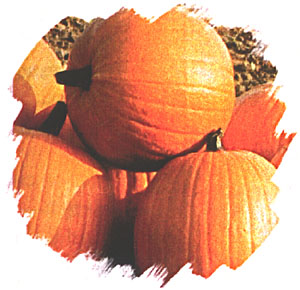Pumpkins in Texas
Crop Brief on Production, Pests, & Pesticides
| Crop Briefs were prepared by Dr. Dudley Smith, Texas Agricultural Experiment Station and Dr. Juan Anisco, Texas AgriLife Extension Service |
| Pumpkin Production |
- Texas is the fourth leading state in commercial pumpkin production, and generates $2.4 million for farmers, with an economic impact of $7.4 million in the state.
- 5,000 to 8,000 acres are planted annually in Texas. 90% are in the west Texas region.
- The pumpkin is a cucurbit, over 90% are produced for seasonal ornamental use.
|
| Insect Pests |
- Insects include squash bugs, cucumber beetles, squash vine borer, and pickleworm.
- Essentially all of the commercial acreage is treated for one or more of these pests. 80% of the pumpkin fields are scouted and IPM practices are followed.
- Two FQPA-targeted insecticides include endosulfan (Phaser), and carbaryl (Sevin – a carbamate) which if lost, would reduce yields and quality by 10% or more.
- 90% of the insecticides are aerially applied since vine growth limits ground operations.
- Synthetic pyrethroids are alternatives for squash bug and the spotted cucumber beetle but are less effective. These two pests reduce yields and stunt pumpkin size.
|
| Diseases |
- Major diseases include powdery mildew, anthracnose, angular leaf spot and blight; other diseases are gummy stem blight, bacterial wilt, black rot, and damping off.
- Non-chemical methods are used to the fullest extent. Crop residue is disked into soil after harvest and 100% of the pumpkin fields are rotated with other crops to reduce diseases.
- Foliar diseases dramatically reduce yields. Protective and preventative fungicides are essential to protect crop foliage.
- The major FQPA-targeted fungicide is chlorothalonil (Bravo), which is used on 100% of the crop. New chemistry in the strobilurin family (azoxystrobin/Quadris and trifloxystrobin/Flint) show promise but are not broad spectrum. Myclobutanil (Nova �Emergency Use/Section 18) is also used in rotation with chlorothalonil for excellent powdery mildew control.
- Three other FQPA-targeted fungicides include benomyl (Benlate � a carbamate), maneb (Maneb � a B2 carcinogen), and thiophanate-methyl (Topsin � a carbamate). These are seldom used but are some of the few fungicides labeled for pumpkin. Nematicides are expensive and rarely used in pumpkin production.
|
| Weeds |
- Weeds reduce yields and cut quality by reducing fruit size. Weeds compete for sunlight, water, and nutrients and also host pathogens, viruses, and insects.
- The most troublesome annual weeds are pigweed, cocklebur, lance leaf sage, several annual grasses, and devils claw. Perennial weeds include johnsongrass, nutsedge, black nightshade, silverleaf nightshade.
- 100% of pumpkin acreage is cultivated (early) and 70% is hand hoed to remove weeds. Rotations with cotton and grain crops to help control weeds.
- Trifluralin (Treflan) is applied early on 20% or more of the crop. In some cases row middles are treated before vines cover the soil.
- Clomazone (Command) and ethalfluralin (Curbit) are applied at planting on 35% of the acreage. While these herbicides are not FQPA-targeted during Phase 1, they are important since options for weed control are limited.
|
| Outlook |
- Pumpkins produce tremendous amounts of foliage, which favor insects and disease. Chemical control is essential, along with cultural control methods. Resistant varieties are not available.
- For the future, pumpkin growers have few herbicide options for weed control. Experimental herbicides that show promise in other countries cause severe injury in pumpkins, even at low rates.
- For latest information regarding these issues and status of risk assessments visit ipmwww.ncsu.edu/opmppiap and www.epa.gov/pesticides.
|
| Crop Briefs is an information series developed by Texas A&M AgriLife of the Texas A&M University System on critical pest problems and pesticide needs for Texas agriculture. This effort is supported by the Texas Vegetable Association, and other commodity groups. Dr. Dudley Smith, Texas Agricultural Experiment Station and Dr. Juan Anciso, Texas AgriLife Extension Service prepared these reports August 2000 using information from numerous sources. Departmental Report SCS-2000-01.The information given herein is for educational programs only. Reference to commercial products or trade names is made with the understanding no discrimination is intended and no endorsement by the Texas AgriLife Extension Service Service and the Texas Agricultural Experiment Station is implied.
Educational programs conducted by Texas A&M AgriLife, Texas A&M University, Texas Agricultural Experiment Station, and the Texas AgriLife Extension Service Service serve people of all ages regardless of socioeconomic level race, color, sex, religion, handicap or national origin. |

